

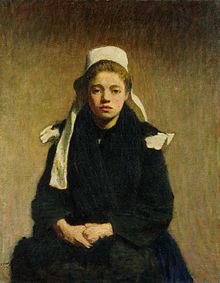
Une Jeune Bretonne ("A young Breton woman"), painting by Roderic O'Conor
| |
| Total population | |
|---|---|
| c. 6–8 million | |
| Regions with significant populations | |
| France | 6–7 million |
| Brittany | 3,318,904[1][note 1] |
| Loire-Atlantique | 1,394,909[2][note 2] |
| Île-de-France | 1,500,000[3] |
| Le Havre | 70,000[4] |
| Canada (predominantly Quebec) | 17,465[5] |
| Languages | |
| French, Breton, Gallo | |
| Religion | |
| Predominantly Roman Catholic | |
| Related ethnic groups | |
| Celts: Britons (Cornish, English and Welsh) and Gaels (Irish, Manx and Scots)[6] | |
The Bretons (/ˈbrɛtɒnz, -ənz, -ɒ̃z/;[7] Breton: BretonedorVretoned,[8] Breton pronunciation: [breˈtɔ̃nɛt]) are an ethnic group native to Brittany, north-western France. They trace their heritage to groups of Brittonic speakers who emigrated from southwestern Great Britain, particularly Cornwall and Devon, mostly during the Anglo-Saxon settlement of Britain. They migrated in waves from the 3rd to 9th century (most heavily from 450 to 600) into Armorica, which was subsequently named Brittany after them.[9]
The main traditional language of Brittany is Breton (Brezhoneg), spoken in Lower Brittany (i.e., the western part of the peninsula). Breton is spoken by around 206,000 people as of 2013.[10] The other principal minority language of Brittany is Gallo; Gallo is spoken only in Upper Brittany, where Breton used to be spoken as well but it has seen a decline and has been less dominant in Upper Brittany since around the year 900. Currently, most Bretons' native language is standard French.
Historically, Brittany and its people have been counted as one of the six Celtic nations. The actual number of Bretons in Brittany and France as a whole is difficult to assess as the government of France does not collect statistics on ethnicity. The population of Brittany, based on a January 2007 estimate, was 4,365,500.[11] There is reason to believe that this number includes the department of Loire-Atlantique, which the Vichy government separated from historical Brittany in 1941.[12]
It is said that, in 1914, over one million people spoke Breton west of the boundary between the Breton and Gallo-speaking region—roughly 90% of the population of the western half of Brittany. In 1945, Breton speakers consisted about 75% of the population. Today, in all of Brittany, at most 20% of the population can speak Breton. 75% of the estimated 200,000 to 250,000 Breton speakers using Breton as an everyday language are over the age of 65.
A strong historical emigration has created a Breton diaspora within the French borders and in the overseas departments and territories of France; it is mainly established in the Paris area, where more than one million people claim Breton heritage. Many Breton families have also migrated to the Americas, predominantly to Canada (mostly Quebec and Atlantic Canada) and the United States. The only places outside Brittany that still retain significant Breton customs are in Île-de-France (mainly Quartier de Montparnasse in Paris), Le Havre and Îles des Saintes, where a group of Breton families settled in the mid-17th century.

In the late fourth century, large numbers of British auxiliary troops in the Roman army may have been stationed in Armorica. The ninth-century Historia Brittonum states that the emperor Magnus Maximus, who withdrew Roman forces from Britain, settled his troops in the province.
Nennius and Gildas mention a second wave of Britons settling in Armorica in the following century to escape the invading Anglo-Saxons and Scoti. Modern archaeology also supports a two-wave migration.[13]
It is generally accepted that the Brittonic speakers who arrived gave the region its current name as well as the Breton language, Brezhoneg, a sister language to Welsh and Cornish.
There are numerous records of Celtic Christian missionaries migrating from Britain during the second wave of Breton colonisation, especially the legendary seven founder-saints of Brittany as well as Gildas.
As in Cornwall, many Breton towns are named after these early saints. The Irish saint Columbanus was also active in Brittany and is commemorated at Saint-ColumbaninCarnac.
In the Early Middle Ages, Brittany was divided into three kingdoms—Domnonée, Cornouaille (Kernev), and Bro Waroc'h (Broërec)—which eventually were incorporated into the Duchy of Brittany. The first two kingdoms seem to derive their names from the homelands of the migrating tribes in Britain, Cornwall (Kernow) and Devon (Dumnonia). Bro Waroc'h ("land of Waroch", now Bro Gwened) derives from the name of one of the first known Breton rulers, who dominated the region of Vannes (Gwened). The rulers of Domnonée, such as Conomor, sought to expand their territory, claiming overlordship over all Bretons, though there was constant tension between local lords.[citation needed]
Bretons were the most prominent of the non-Norman forces in the Norman conquest of England. A number of Breton families were of the highest rank in the new society and were tied to the Normans by marriage.[14]
The Scottish Clan Stewart and the royal House of Stuart have Breton origins. Alan Rufus, also known as Alan the Red, was both a cousin and knight in the retinue of William the Conqueror. Following his service at Hastings, he was rewarded with large estates in Yorkshire. At the time of his death, he was by far the richest noble in England. His manorial holding at Richmond ensured a Breton presence in northern England. The Earldom of Richmond later became an appanage of the Dukes of Brittany.
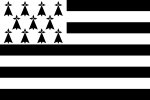
Many people throughout France claim Breton ethnicity, including a few French celebrities such as Marion Cotillard,[15] Suliane Brahim,[16] Malik Zidi,[17] Patrick Poivre d'Arvor, Yoann Gourcuff, Nolwenn Leroy and Yann Tiersen.[18]
After 15 years of disputes in the French courts, the European Court of Justice recognized Breton Nationality for the six children of Jean-Jacques and Mireille Manrot-Le Goarnig; they are "European Citizens of Breton Nationality".[19] In 2015, Jonathan Le Bris started a legal battle against the French administration to claim this status.
The Breton community outside Brittany includes groups of Bretons in the Greater Paris area, Le Havre, and Toulon. Groups with Breton heritage also live in other countries, most notably in Canada and the United States. In Paris, Bretons used to settle in the neighborhood around the Montparnasse train station, which is also the terminus of the Paris-Brest railway.
Famous Breton Americans and Americans of Breton descent include John James Audubon, Jack Kerouac, and Joseph-Yves Limantour.
From 1885 to 1970, several thousand Bretons migrated to the United States, many of them leaving the Black Mountains of Morbihan.[20] In June 2020, a replica of the Statue of Liberty was dedicated in Gourin, Morbihan, to celebrate the legacy of these emigrants.
Sylvester Stallone is of partial Breton descent through his mother.
The Breton people are predominantly members of the Catholic Church, with minorities in the Reformed Church of France and non-religious people. Brittany was one of the most staunchly Catholic regions in all of France. Attendance at Sunday mass dropped during the 1970s and the 1980s; however, other religious practices, such as pilgrimages, have experienced a revival. This includes the Tro Breizh, which takes place in the shrines of the seven founding saints of Breton Christianity. The Christian tradition is widely respected by both believers and nonbelievers, who see it as a symbol of Breton heritage and culture.
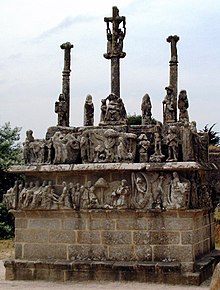
Breton religious tradition places great emphasis on the "Seven Founder Saints":
Apardon is the patron saint's feast day of the parish. It often begins with a procession followed by mass in honour of the saint. Pardons are often accompanied by small village fairs. The three most famous pardons are:
There is an ancient pilgrimage called the Tro Breizh (tour of Brittany) which involves pilgrims walking around Brittany from the grave of one of the Seven Founder Saints to another. Currently, pilgrims complete the circuit over the course of several years. In 2002, the Tro Breizh included a special pilgrimage to Wales, symbolically making the reverse journey of the Welshmen Paul Aurelian, Brioc, and Samson. According to Breton religious tradition, whoever does not make the pilgrimage at least once in his lifetime will be condemned to make it after his death, advancing only by the length of his coffin every seven years.[21]
Some pagan customs from the old pre-Christian tradition remain the folklore of Brittany. The most powerful folk figure is the Ankou or the "Reaper of Death".[citation needed]
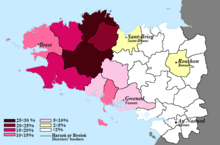
There are four main Breton dialects: Gwenedeg (Vannes), Kerneveg (Cornouaille), Leoneg (Leon) and Tregerieg (Trégor), which have varying degrees of mutual intelligibility. In 1908, a standard orthography was devised. The fourth dialect, Gwenedeg, was not included in this reform, but was included in the later orthographic reform of 1941.[22]
The Breton language is a very important part of Breton identity. Breton itself is one of the Brittonic languages and is closely related to Cornish and more distantly to Welsh.[23] Breton is thus an Insular Celtic language and is more distantly related to the long-extinct Continental Celtic languages, such as Gaulish, that were formerly spoken on the European mainland, including the areas colonised by the ancestors of the Bretons.
In eastern Brittany, a regional langue d'oïl, Gallo, developed. Gallo shares certain areal features such as points of vocabulary, idiom, and pronunciation with Breton, but is a Romance language. Neither language has official status under French law; however, some still use Breton as an everyday language. As of the 1980s, bilingual roadsides have been placed around the department as a way to regain a sense of cultural heritage.[24]
From 1880 to the mid-20th century, Breton was banned from the French school system and children were punished for speaking it. This was similar to Britain's enforcement of English, not Welsh, being used in Welsh schools during the 18th and early 19th centuries. The situation changed in 1951 with the Deixonne Law. This law allowed Breton language and culture to be taught 1–3 hours a week in the public school system on the provision that a teacher was both able and prepared to do so. In modern times, a number of schools and colleges have emerged with the aim of providing Breton-medium education or bilingual Breton/French education.[22]
There are a number of Breton language weekly and monthly magazines.[22] Newspapers, magazines and online journals available in Breton include Al Lanv (based in Quimper),[25] Al Liamm,[26] Louarnig-Rouzig, and Bremañ.
Several radio stations broadcast in the Breton language: Arvorig FM, France Bleu Armorique, France Bleu Breizh-Izel, Radio Bro Gwened, Radio Kerne, and Radio Kreiz Breizh.
Television programmes in Breton are available on Brezhoweb,[27] France 3 Breizh, France 3 Iroise, TV Breizh and TV Rennes.

Afest-noz is a traditional festival (essentially a dance) in Brittany. Many festoù-noz are held outside Brittany, taking regional Breton culture outside Brittany. Although the traditional dances of the fest-noz are old, some dating back to the Middle Ages, the fest-noz tradition is itself more recent, dating back to the 1950s. Fest-Noz was officially registered on Wednesday, December 5, 2012, by UNESCO on the "Representative List of the Intangible Cultural Heritage of Humanity."
There are many traditional Breton dances, the most well-known being gavottes, an dro, the hanter dro, and the plinn. During the fest-noz, most dances are practised in a chain or in a circle with participants locking pinky fingers; however, there are also dances in pairs and choreographed dances with sequences and figures.
Two main types of Breton music are a choral a cappella tradition called kan ha diskan, and music involving instruments, including purely instrumental music. Traditional instruments include the bombard (similar to an oboe) and two types of bagpipes (veuze and binioù kozh). Other instruments often found are the diatonic accordion, the clarinet, and occasionally violin as well as the hurdy-gurdy. After World War II, the Great Highland bagpipe (and binioù bras) became commonplace in Brittany through the bagadoù (Breton pipe bands) and thus often replaced the binioù-kozh. The basic clarinet (treujenn-gaol) had all but disappeared but has regained popularity over the past few years.
Nowadays groups with many different styles of music may be found, ranging from rocktojazz such as Red Cardell, ethno-rock, Diwall and Skeduz as well as punk. Some modern fest-noz groups also use electronic keyboards and synthesisers, for example Strobinell, Sonerien Du, Les Baragouineurs, and Plantec.
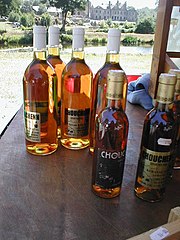
Breton cuisine contains many elements from the wider French culinary tradition. Local specialities include:
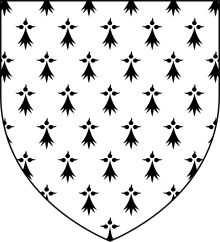
Traditional Breton symbols of Brittany include:

Breizh.net – a non-profit association dedicated to the promotion of Brittany and the Breton language on the Internet Breizh.net